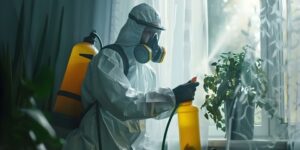Armis Pest Management plan goes beyond simply calling a pest control service when an infestation appears. It involves regular inspections to identify and treat pests before they cause serious damage.
Scouting and monitoring help to determine pest species and population levels accurately. This allows action thresholds to be set so that economic or aesthetic injury does not occur.

Preventative Measures
One of the best ways to keep pests away from your property is to prevent them from getting a foothold on it in the first place. They tend to be attracted to properties that offer food, water, and shelter — things you can control by keeping your property well-maintained and removing attractants.
In residential settings, pests can enter the property from outside or migrate inside through a variety of methods such as open trash containers, leaking pipes, and cracks in foundation walls and other areas. Preventative measures that can be taken include storing trash in airtight containers and cleaning up food spills or crumbs.
It’s also a good idea to clean up outdoor spaces and other structures, such as sheds, that are located near the home to ensure they don’t provide shelter for pests. Finally, a regular inspection of the property to check for signs of pest activity is an important part of pest prevention, including checking the condition of weather stripping around doors and windows. Replacing worn or missing weather stripping is an inexpensive maintenance task that reduces drafts and improves energy efficiency.
Commercial property owners can take steps to protect their properties by implementing integrated pest management (IPM) programs. IPM is a systematic approach to managing pests, which involves monitoring and scouting to identify pest species and assess their damage level. This information is used to establish economic or aesthetic injury thresholds, which are levels at which action should be taken to mitigate pest populations.
When scouting and monitoring pests, IPM program staff must be able to accurately identify the pests being encountered and their host plants. This helps to ensure that the appropriate action is being taken, whether that’s a chemical spray or some other form of control. IPM also involves using natural predators and parasitoids to manage pest populations rather than relying on chemicals. For example, IPM professionals might use nematodes to manage mite populations, or predatory insects to control plant-feeding pests such as millipedes and green June beetle grubs. These natural control organisms usually occur naturally in the environment and have a lower impact on the surrounding ecosystem.
Monitoring
Whether it’s termites gnawing through the foundation of your home or ants crawling across the kitchen counter, pests are annoying and inconvenient. To keep them away from your property, a comprehensive approach is necessary, one that includes prevention, monitoring, suppression, and eradication tactics.
The first goal of an integrated pest management plan is to prevent problems. Preventive measures may include sanitation, exclusion techniques, trapping, and other non-chemical methods. In addition, preventive actions often involve selecting and growing pest-resistant or tolerant plants.
To determine if preventive steps are working, pest populations must be monitored regularly. Sampling should be done in the field, building, or garden using a consistent sampling method. Samples can be collected by hand, with traps, or a combination of both. Insects, weeds, and diseases are usually easiest to monitor in their immature or juvenile stages.
Scouting and monitoring allow pests to be identified accurately, enabling you to set action thresholds for when control is needed. For example, a threshold might be reached when the pest population or damage is above an economic or aesthetic injury level. This information helps focus treatment strategies and select the most effective, least toxic control options.
Depending on the type of pest, environmental conditions, and timing can also be important factors in controlling them. Monitoring allows you to track pest populations and identify environmental conditions that favor them, such as weather food or harborage availability. In addition, you can monitor the effect of natural enemies, such as predators, parasites, or disease pathogens, which may help control them.
Once a pest problem is detected, it’s time to take action. This phase of the program can involve a combination of physical, mechanical cultural, biological, or chemical controls, and is typically aimed at suppressing pests to a point where they no longer cause unacceptable harm to your property. If a particular treatment is used, it’s often important to follow proper application guidelines to limit the use of chemicals and minimize health and environmental risks. In most cases, pests will be controlled with minimal pesticide use.
Suppression
Invasive pests can cause damage that reduces the value of landscaped areas and structures, degrades soil quality, and interferes with human activities. They may be insects, diseases, weeds, viruses, nematodes, or vertebrates (e.g., rats, mice, rabbits, hares, snakes).
The first step in suppressing pests is to remove their food and water sources. This prevents them from being able to find shelter or breed. Store garbage in sealed containers regularly take out the trash, and make sure that there are no puddles or standing water on the property.
It is also important to make sure that water is not being wasted through irrigation systems or in other ways on the property. This water can provide a source of drinking water for wildlife and other unwanted pests. During monitoring, workers should positively identify pests so that they know what type of control action is needed. This will help them to select the best biological, chemical, or other management methods for controlling them. It will also help them to determine whether the problem is a continuous pest that requires regular control, a sporadic or migratory pest that can be controlled under certain conditions, or a potential pest that may need to be managed in the future.
Once the tolerance level of a pest is determined, then it is necessary to use one of the control options available to keep pest populations below that threshold. This might include using a natural predator or parasite, or it might involve using a targeted application of a chemical insecticide, which is generally less toxic than broadcast spraying of non-specific or broad-spectrum pesticides. Whenever possible, the pesticide should be selected to target only the pest and not its beneficial co-occupants. The timing of pesticide applications is important, as well, since some stages of a pest’s life cycle are more susceptible to control than others.
Using the principles of prevention and suppression will lead to successful control of many pests. However, if the problem persists, then more extensive measures may be required. Eradicating pests is expensive, disruptive to the environment, and a violation of tenants’ rights. It is much cheaper to prevent pests in the first place by following preventive steps.
Eradication
Even after careful maintenance, a property may experience pest infestations. An infestation is a significant increase in the number of a pest species that negatively affects human health, property, or environment. Infestations are often an indicator of a serious problem and can have devastating effects on the quality of life for residents in apartment buildings, office buildings, or homes.
Preventing a pest infestation begins with knowing what attracts pests to the premises. All pests seek food, water, and shelter. Keeping living spaces clean and uncluttered will lessen their appeal. Food should be stored in tightly sealed containers and trash should be kept in secure bins. Cracks, crevices, and other entry points should be filled with caulking or steel wool to prevent critters from entering the living space.
Regular yard care is also important in preventing pests, including trimming shrubs, and trees and removing debris from the exterior of the building. Keeping these areas neat will deter pests from hiding out in bushes or under overgrown grasses.
Biological methods are often effective for controlling pests, particularly insects. These methods are typically based on the use of organisms that kill or repel their target insect. For example, a common caterpillar predator is the bacterium Bacillus thuringiensis (Bt). It releases a toxin into its host that breaks down the midgut of the caterpillar. This method is effective on over 400 different insect species and does not harm people, pets, or plants.
A thorough inspection should be performed to identify the types and numbers of pests on the property. This inspection should include the interior of each home or apartment, outside the building, in garages and basements, and the attic, if applicable.
If a problem is identified, a treatment plan should be developed using a combination of mechanical, cultural, biological, and chemical methods. This will help reduce the amount of pesticides used and ensure that the correct type and quantity of pesticide is applied safely.
When an infestation is discovered, apartment buildings and condominiums may provide fumigation services to their tenants free of charge. This will be especially helpful if the problem is thought to have crept from neighboring apartments or homes. In suburban or rural settings, homeowners’ associations or neighborhood groups may offer similar resources. If a homeowner wants to take this route, they should be sure to use high-quality, toxicity-conscious exterminators.


